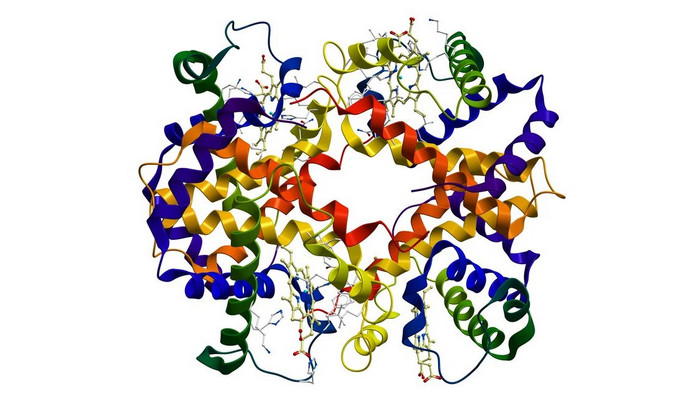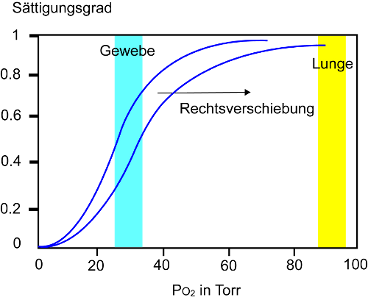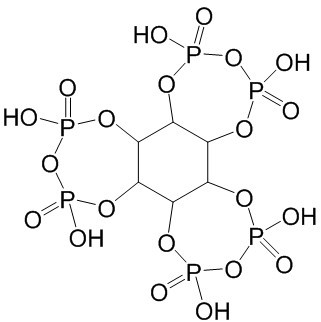ITPP (Myo-inositol trispyrophosphate)

Physiologische und pharmakologiache Wirkungen
Myo-inositol trispyrophosphate (ITPP) ist ein allosterischer Regulator des Hämoglobins und reduziert die Sauerstoffbindungsaffinität. Dabei verschiebt ITPP die Sauerstoffbindungskurve des Hämoglobins nach rechts und verbessert somit die Sauerstofffreisetzung aus den Blutgefäßen ins Gewebe (Abb.1).
In Tierversuchen mit ITPP konnte eine verbesserte Sauerstoffversorgung des Gewebes und eine dosisabhängige Verbesserung der Ausdauerleistung gezeigt werden [1, 2].
Von medizinischem Interesse ist ITTP zur Behandlung von Krebs in Verbindung mit einer Chemotherapie [3]. Klinische Studien wurden bereits 2014 unter dem Substanznamen OXY111A aufgenommen [4]
Literatur
[1] T. Watanabe. Reduction in hemoglobin–oxygen affinity results in the improvement of exercise capacity in mice with chronic heart failure. J. Am. Coll. Cardiol. 2008, 52, 779.
[2] A. Biolo, R. Greferath, D. A. Siwik, F. Qin, E. Valsky, S. Pothukanuri, C. D. Duarte, R. P. Schwarz, J. M. Lehn, C. Nicolau, W. S. Colucci. Enhanced exercise capacity inmice with severe heart failure treated with an allosteric effector of hemoglobin, myo-inositol trispyrophosphate. [1]Proc. Natl. Acad. Sci. 2009, 106, 1926.
[3] Limani P, Linecker M, Schneider MA, Kron P, Tschuor C, Kachaylo E, Ungethuem U, Nicolau C, Lehn JM, Graf R, Humar B, Clavien PA. The Allosteric Hemoglobin Effector ITPP Inhibits Metastatic Colon Cancer in Mice. Ann Surg. 2017 Nov;266(5):746-753.
[4] Limani P, Linecker M, Kron P, Samaras P, Pestalozzi B, Stupp R, Jetter A, Dutkowski P, Müllhaupt B, Schlegel A, Nicolau C, Lehn JM, Petrowsky H, Humar B, Graf R, Clavien PA. Development of OXY111A, a novel hypoxia-modifier as a potential antitumor agent in patients with hepato-pancreato-biliary neoplasms - Protocol of a first Ib/IIa clinical trial.BMC cancer, (2016) 16(1), 812.

Dopingrelevanz und Nachweis
Für Ausdauersportler könnte ITPP (Abb.2) aufgrund der möglichen Eigenschaft, dass die Sauerstoffversorgung der Muskulatur verbessert werden kann, zur unerlaubten Leistungsoptimierung von Interesse sein.
ITPP wirkt somit ähnlich wie die verbotene Dopingsubstanz RSR13.
RSR13 (Efaproxiral) ist namentlich auf der WADA Verbotsliste unter der Gruppe
Verbotene Methoden M2 Manipulation von Blut und Blutkomponeneten aufgelistet.
siehe auch Artikel RSR13

Die Substanz ITPP steht zurzeit (2019) namentlich nicht auf der WADA Liste der verbotenen Substanzen. Sie wird aber aufgrund ihrer ähnlichen Wirkung wie RSR13 als verwandlte Verbindung eingestuft und ist damit dopingrelevant. Weiterhin kann die Substanz auch zur verbotenen Gruppe S0 Nicht zugelassene Wirkstoffe eingestuft werden.
Eine entsprechende Nachweismethode wurde im Zentrum für Präventive Dopingforschung der Deutschen Sporthochshule Köln von Görgens et al. 2014 entwickelt und publiziert:
Görgens C, Guddat S, Schänzer W, Thevis M. Screening and confirmation of myo-inositol trispyrophosphate (ITPP) in human urine by hydrophilic interaction liquid chromatography high resolution / high accuracy mass spectrometry for doping control purposes. Drug Test Anal. 2014 Nov-Dec;6(11-12):1102-7.
- Abstract
Myo-inositol trispyrophosphate (ITPP) is a novel allosteric effector of haemoglobin with high permeation selectivity across the red blood cell plasma membrane. Due to its potential to reduce the oxygen affinity of haemoglobin, ITPP application results in an enhanced oxygen release in hypoxic tissues. Therefore, ITPP is being examined for the treatment of numerous illnesses that involve hypoxia, such as cardiovascular diseases, cancer or Alzheimer’s disease. Similar to the prohibited substance Efaproxiral®, ITPP increases maximal exercise capacity in mice, providing high potential to be misused in sports. To keep up with cheating athletes, a fast and reliable liquid chromatography-tandem mass spectrometry (LC-MS/MS) method for screening and confirmation of ITPP in human urine for doping control purposes was developed. According to the molecule’s distinct hydrophilic properties, extraction from complex biological matrices is challenging and conventional reversed phase liquid chromatography (RPLC) separations are not suitable for its detection. Therefore an approach based on hydrophilic interaction liquid chromatography (HILIC) Orbitrap mass spectrometry was established. The methodology was fully validated for qualitative purposes. Screening and confirmation assay are characterized by satisfactory specificity and robustness, adequate intra-day (screening: 4.9–8.1%; confirmation: 2.0–6.7%) and inter-day precision (screening: 4.6–9.1%; confirmation: 1.8–6.6%), excellent linear correlations (>0.99) with sufficient LLOD in the sub ng/mL range (screening: 15 ng/mL; confirmation: 1 ng/mL). In addition it could be shown that ITPP is stable in human urine under the mandatory storage period and conditions for doping control laboratories. To our knowledge, this is the first validated ‘dilute-and-inject’ LC-MS/MS method for the reliable detection of ITPP in human urine.
Weitere Literatur
Görgens C, Guddat S, Södje D, Geyer H, Thevis M: Detection of myo-inositol trispyrophosphate (ITPP) in human urine following an oral administration of ITPP – a pilot study. In: Thevis M, Geyer H, Mareck U (eds.) Recent advances in doping analysis (26). Sportverlag Strauß, Köln (2018) 109 113
download des Artikels
Lam G, Zhao S, Sandhu J, Yi R, Loganathan D, Morrissey B. Detection of myo-inositol tris pyrophosphate (ITPP) in equine following an administration of ITPP. Drug Test Anal. 2014 Mar;6(3):268-76.
Abstract